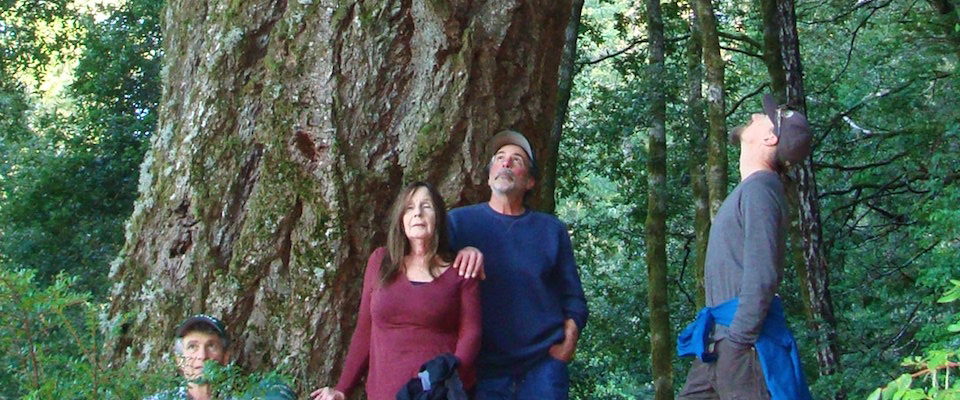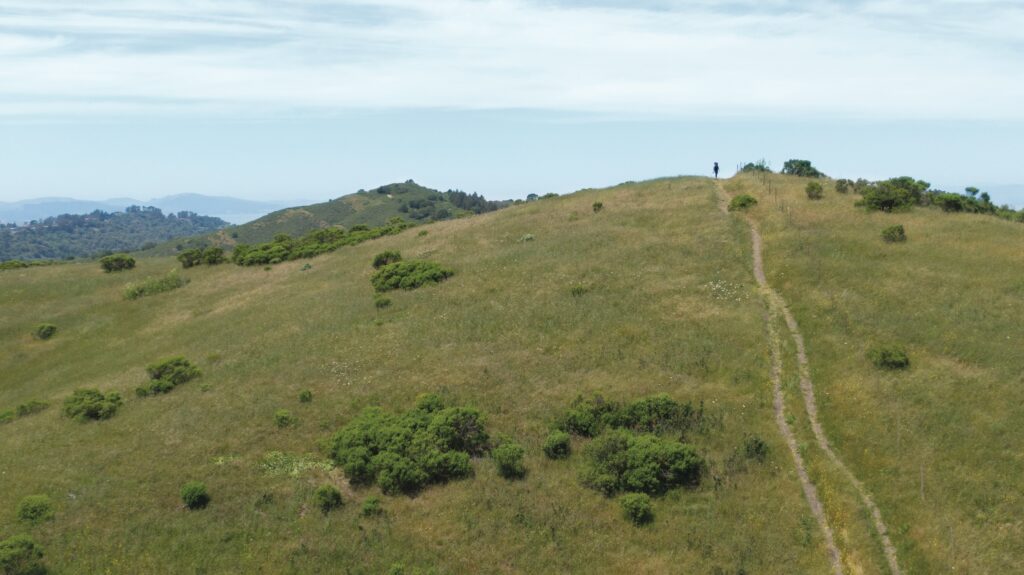On New Year’s Eve 2012, having returned early from an East Coast holiday with our kids, and with an 8 p.m. dinner invite ahead of me and no one to say no, I drive to Pantoll to do a run to Stinson. I’ve been running the Marin Headlands for 41 years and this is something I have contemplated doing for years.
Because the only afternoon bus back up to my car is at 5 p.m., I start a few minutes after 3. The last part is a 1,500-foot descent down a drop-dead gorgeous, wide-open, thick duff, high-canopy redwood forest ridge line. Things go smoothly and I hit bottom at 4:20 with 40 minutes left to go and less than a half mile to the bus. Just as I figure, the last leg is a streambed. Every stream I’ve encountered thus far—be it Muir Woods, Four Corners, Cascade Canyon, Blithedale Canyon or Big Rock Ridge—has been an easy meandering thing between broad banks. So I have no worries.
But this one is different. It is a raging torrent squeezed between two tall, near-vertical cliff faces. Not what I signed up for. Anxious to stay dry on that unusually cold night, I go back upslope to get around the stream but only use up valuable time. Suddenly, it’s too dark for that to work, so I return to the stream as the one sure way to get out without getting lost. Trying to step along ledges, I am soon wet to the knees. Dark descends and when I put my hand out to steady myself, there is nothing there and I fall face first into the water.
Certain I can do it right the second time, I watch my hand pass though a void so densely dark it just has to be solid. This time I tumble head over heels down a 15-foot cataract, thinking that the next step could be a 20-foot drop to a lights-out cracked skull. Game Over. I pull myself out of the water, sit down next to the roaring creek and decide that it’s a better option to be stranded, soaking wet and shivering violently, all through one of the longest nights of the year until enough light makes it possible to walk out, than to run the risk of packing it in altogether and really piss off a whole bunch of people.
Rescue? My iPhone has been submerged twice so that seems unlikely. But I pull it out just to make sure. Thank you, Steve Jobs! It is still working with 30% left, kicking off a whole new chapter in this saga.
I call 911. I hear a flat voice that is seemingly impervious to my plight. I am referred to another jurisdiction. When no one picks up, I call 911 again. A new flat voice answers and we start all over from the top. After a protracted discourse, I am referred to an agency that has no idea how to find Mt. Tam. In the midst of my trying to tell my story the voice blurts out, “ARE YOU IN A CAR?”
“Look at any online map, zoom to Stinson Beach to see two residential areas east of the highway,” I implore over and over again. I say repeatedly, “I am up a stream that outfalls into the upper northeast corner of the southern residential area.”
I am not able to reference street names since I cannot see any. (The very next day, roads will again be visible on my phone, thanks to Apple and Google deciding to make nice again. But today I have to worry about Death by AppleMap!) Disappointingly, no one I talk to seems to have any interactive mapping of any kind. When they finally manage to get a coordinate for my location it’s at my car, five miles away, as though returning to one’s car on foot is the only viable option. I am put on hold again.
With the phone at 12% and the air getting colder, I call 911 again, and when I get yet another new person who has no record of my previous calls I hang up and call 411. This time I have the Stinson Beach Fire Department. The friendly voice of Fire Captain Toby Bisson comes on the line and immediately knows I am along a high-volume stream not far upslope from the houses.
Soon a helicopter is overhead. I climb up some 60 feet from the deep trough of the streambed so they can see me. I flash my Search Light app but seconds later the phone goes dead. I sit down. It is so dark that one second I am shifting my weight to get more comfortable and the next I am falling uncontrollably and blindly down a 60-foot cliff face to the stream. I pull my soaked sweatshirt over my head and make it into a tent to trap my breath. I shake violently as it gets colder.
Concerned about losing a digit, I warm my hands in my armpits, take off my soaked shoes and socks and massage my toes, or at least the assembly of dead nerve endings at the far end of my foot. I repeatedly warm my hands and massage my feet until, after about two hours, my toes came back to life. Then it gets colder. I repeat the hand-foot cycle every 15 minutes for six hours, capable of only two thoughts: “Will I make it through the night?” alternating with “Is anyone coming to get me?”
Right in the middle of a fresh wallow in self-pity I notice twinkling downstream—tiny wiggly headlamps coming toward me. It is the sweetest, toughest Medevac team just in from the center of a perfect world. Their names are Ken and Kevin and Charles and Teal.
Everyone is excited. I am not going to die and FINALLY the rescue party has a live body to save rather than training dummies. This is not a drill. Stinson Beach Fire Protection District’s few and finest are joined by volunteers answering this New Year’s Eve call to action from Sonoma, Contra Costa and Solano counties.
Teal soon has my pulse retreating from a shaking-induced high of 65 and I am in the stretcher on my way out, assisted by of all manner of zip-lines and lanyards competing for the real-time proven best-practice award. All around me relationships are enriched, networks tightened and leadership tested and perfected.
With the average carry or slide being about 6 feet a minute, the 250 yards to the road is crossed in around four hours of relentless, competent toil. Their energy, physical fitness, gentleness, patience (with me and each other), intelligence and humility will make them, forever, the one group of people with whom I would most prefer to spend New Year’s Eve.
Four hours later I am in an ultra-warm ambulance that is ready to take me to Kaiser for my lacerated hand. Thanks to my amazing rescuers I feel so good that I convince them to save their fully staffed emergency vehicle for a more worthy patient. They take me to my car, where I sign a release and drive myself to Kaiser.
So why this attempt to immortalize a debacle? It’s to thank the volunteers. That night I learned that the survival of a single person is not unlike the survival of an entire culture. Both require a commitment to the idea that “We are all in this together.” On New Year’s Eve 2012, I got to meet some of the “in this together” priesthood. Since the stretcher work was done in shifts, I got a good look at nearly every face. What I saw in each was “I gave up my New Year’s Eve plans just to keep someone from dying and all I get in return is this euphoric feeling that I did it.”
A lesson offered that night is one that addresses the question: How can the natural world, so benign and friendly and full of grace in daylight, so quickly become a murky, damp, freezing abyss riddled with precipices and pitfalls quite ready to cause my death? The answer is still rattling around in my head. More certain, the 8 hours of bone-rattling shivering, not knowing if I was going to make it or not was a terrifying, painful, judicious punishment for not being more careful.
That brings us back to the 30-person Search and Rescue who relentlessly waded up a creek until they found me, who bandaged my wounds, monitored my vital signs, warmed me up and carried me out. This “California 30” was, among so many other things, dead-on validation of my patience-of-Job obsession that America is a successful country.
One in a series of personal Perspectives. We invite readers to submit their own essays—inspiration can come from CALIFORNIA magazine or CALIFORNIA Online stories, the news, issues of the day, or campus life. Read more:




















